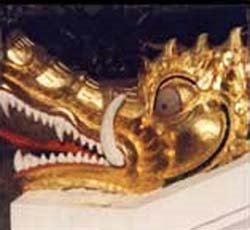Festival of the Reversing Current (Bon Om Tuk) Cambodia November 2006
 Strangely, the current of the Tonle Sap river, which runs through Phnom Penh Cambodia from the Tonle Sap Lake to the Mekong, switches direction each November.
Strangely, the current of the Tonle Sap river, which runs through Phnom Penh Cambodia from the Tonle Sap Lake to the Mekong, switches direction each November.During the heyday of the Khmer Empire, the rulers were thought to have the power to effect this reversal; nowadays, it's the occasion for fabulous boat races on the river at Phnom Penh Cambodia in Asia. This area has Cambodia Hotels give your choice...
The festival always takes place around the full moon in November. Each boat is paddled by 40 rowers and decorated with incredible care and attention.
Normally, the racing boats are kept safe and sound inside the Buddhist temple precincts. The prows are carved into naga heads, which are symbolic figures in Hindu and Buddhist mythology, representing rainbows, fertility and water.
On the first day, eyes are painted onto the prows, and more than 100 boats assemble on the Mekong. The rowers are kept in time by a skipper who beats out the rhythm using a ceremonial paddle. The boats traditionally carry "fools", who keep the onlookers amused with satirical jokes. Then for three days, the canoes race against each other in pairs until a final winner is declared.
As the sun sets on the last day of the festival, the grand finale makes this one of the greatest spectacles the world can offer. All the boats line up on the Mekong and the most beautifully decorated vessel then sails calmly out alone into the centre of the river where it performs the "cutting of the string" ceremony. Only when this has been completed can the people be sure they have dutifully honoured the mighty Mekong and ensured that the floods are over for the year.
Source: guides.hotelbook.com


















0 Comments:
Post a Comment
<< Home